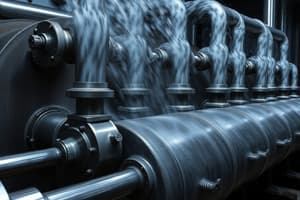Podcast
Questions and Answers
Explain the difference between caldera and crater.
Explain the difference between caldera and crater.
Calderas are generally larger than craters; material comes from a magma chamber for calderas, while material for craters comes out of a vent. Calderas form when the magma chamber roof collapses, whereas craters form when the rim collapses back into the vent.
What is a caldera?
What is a caldera?
A caldera is formed when a magma chamber that supplies material to a volcano empties and its roof collapses, causing the ground to sink, leaving a large circular depression.
What is a crater?
What is a crater?
A crater results from explosions of material out of the vent as well as the collapse of material from the crater's rim back into the vent.
How can ash from a volcanic eruption be hazardous? (Select all that apply)
How can ash from a volcanic eruption be hazardous? (Select all that apply)
Why do cinder cone volcanoes have narrower bases and steeper sides than shield volcanoes?
Why do cinder cone volcanoes have narrower bases and steeper sides than shield volcanoes?
What two factors may cause solid rock to become magma?
What two factors may cause solid rock to become magma?
What is the Ring of Fire?
What is the Ring of Fire?
Why do most volcanoes occur at the boundaries of tectonic plates?
Why do most volcanoes occur at the boundaries of tectonic plates?
What type of material does high pressure produce?
What type of material does high pressure produce?
What type of material does low pressure form?
What type of material does low pressure form?
How is a seismograph used to predict volcanic eruptions?
How is a seismograph used to predict volcanic eruptions?
How does a tiltmeter predict volcanic eruptions?
How does a tiltmeter predict volcanic eruptions?
What is the difference between lava and magma?
What is the difference between lava and magma?
What is the difference between lava and pyroclastic material?
What is the difference between lava and pyroclastic material?
What is the difference between a cinder cone volcano and a shield volcano?
What is the difference between a cinder cone volcano and a shield volcano?
Name four types of lava.
Name four types of lava.
Describe blocky lava.
Describe blocky lava.
Describe pahoehoe lava.
Describe pahoehoe lava.
Describe Aa lava.
Describe Aa lava.
Describe pillow lava.
Describe pillow lava.
The type of magma that often produces a violent eruption is what?
The type of magma that often produces a violent eruption is what?
When lava hardens quickly to form ropy formations, it is called what?
When lava hardens quickly to form ropy formations, it is called what?
Volcanic dust & ash can remain in the atmosphere for months or years, causing what?
Volcanic dust & ash can remain in the atmosphere for months or years, causing what?
Mount St. Helens covers the city of Spokane, WA with tons of ash. Its eruption would most likely be described as what?
Mount St. Helens covers the city of Spokane, WA with tons of ash. Its eruption would most likely be described as what?
Magma forms within the mantle most often as a result of what?
Magma forms within the mantle most often as a result of what?
Flashcards are hidden until you start studying
Study Notes
Volcano Definitions and Differences
- Caldera: A large circular depression formed by the collapse of the ground after a magma chamber empties.
- Crater: A smaller depression that results from explosive material ejection and the collapse of the rim back into the vent.
- Comparison: Caldera generally larger than craters; calderas form from magma chamber collapse, while craters form from vent ejecta.
Volcanic Hazards
- Ash Hazards: Ash can block sunlight, damage trees and buildings, harm crops by smothering and burning, and cause flooding by plugging rivers.
Types of Volcanoes
- Cinder Cone Volcanoes: Have narrower bases and steeper sides; composed of pyroclastic materials leading to their structure.
- Shield Volcanoes: Characterized by broad bases and gentle slopes; formed from runny lava with non-explosive eruptions.
Magma Formation
- Solid to Magma Transition: Solid rock becomes magma when temperature increases or pressure decreases.
Tectonic Plates and Volcanoes
- Ring of Fire: A region of tectonic plate boundaries surrounding the Pacific Ocean, known for high volcanic activity.
- Volcano Location: Most volcanoes occur at tectonic plate boundaries where magma can easily travel to the surface.
Pressure and Material States
- High Pressure: Leads to solid material.
- Low Pressure: Results in liquid material.
Volcanic Prediction Technology
- Seismograph: Detects small earthquakes that often occur prior to an eruption, aiding in prediction.
- Tiltmeter: Measures slope angle; bulging indicates magma movement within the volcano.
Lava vs. Magma
- Magma: Found underground in chambers beneath volcanoes.
- Lava: The molten rock that reaches the Earth’s surface.
Lava Types Comparison
- Lava vs. Pyroclastic Material: Lava consists of varied molten rock types; pyroclastic includes rock fragments and gases.
Types of Lava
- Blocky Lava: Thick and stiff; moves slowly across the ground.
- Pahoehoe Lava: Forms a smooth, glassy surface with rounded wrinkles; flows slowly.
- Aa Lava: Quick flowing; has a jagged surface and forms a brittle crust.
- Pillow Lava: Forms underwater, creating rounded lumps resembling pillows.
Eruption Characteristics
- Violent Eruptions: Often produced by thick magma with high silica content.
- Explosive Eruptions: Characterized by significant ash production and explosive lava activity.
Environmental Impact
- Volcanic Dust: Can linger in the atmosphere for extended periods, causing decreased solar reflection and lower temperatures.
- Mount St. Helens Eruption: Described as explosive, impacting regions with a significant ash fall, such as Spokane, WA.
Magma Formation Conditions
- Common Process: Most magma forms in the mantle due to high temperatures and low pressure conditions.
Studying That Suits You
Use AI to generate personalized quizzes and flashcards to suit your learning preferences.




